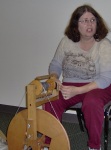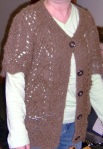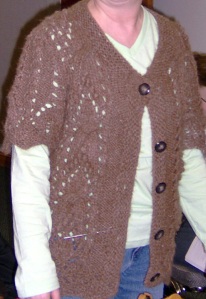Hello dear fiber friends!
I spent another enjoyable evening with our spinning guild members. The conversation drifts effortlessly from topic to topic encompassing current events, spinning technique & tips, recipes, what’s new, fiber terminology, animal husbandry…and so on. It’s as varied as the background and experience of every one of our members!
One discussion in particular was NATURAL DYEING. Judy commented that she has a lovely prolific mulberry tree in her yard and would love to know what/how to dye with its fruit? So, never having dyed with anything ‘mulberry’, I decided to do a little research.
Dyer’s mulberry or FUSTIC, was introduced into Europe in the 16th century and became one of the most popular sources of YELLOW because of its strong tinctorial qualities. The strength of its coloring made it more economical than other yellow dyes and it was often used with indigo to make green. The fustic dyestuff was made from the hardwood/wood chips – not the mulberry fruit! Simmering the dye bath for a longer period tends to produce ‘mustard’ tones and the use of iron as a modifier gives shades of olive green.
Another resource indicated that white mulberry gives yellow; black mulberry and its fruit, violet; red and greyish colours are obtained with use of different mordants. The leaves of the vine give olive green when brought in contact with galvanised iron and almost orange when treated with alkaline salts. I also found “mulberry natural dye extract” made from nettles and spinach and is so safe it can be used as a food colouring!
Did you know…natural dyes are often referred to as vegetable dyes, though many are obtained from animal and mineral sources. Despite the introduction of good quality synthetic dyes, which are reasonably cheap and plentiful, natural dyes produce a subtle beauty of tone that perhaps may never been equalled by use of even the finest synthetic dyes. Natural dyes also come from roots, flowers, leaves, fruits and barks of plants, or from animal sources such as cochineal and or mineral sources such as red soils. The natural dyes had the advantage of being found in abundance in the natural environments. Red is obtained from the roots of the madder plant (Rubia tinctorum) and also from the crushed bodies of female insects of the coccus cacti genus. Yellow is made from the reseda plant, vine leaves and pomegranate skins. Blue is derived from Indigo plants…and so on!
If you have an adventurous spirit, consider planting a few common natural dye plants in your garden this Spring! Some dye stuff plants to consider: hollyhock, chamomile, pot marigold (calendula), coreopsis, cosmos, dahlia, ivy, hibiscus, daffodil, rhubarb, rudbeckia, elderberry, french marigold, comfry, to name a few. OR, wild craft walnut, apple, goldenrod, common yarrow, nettle, dandeliononion skins and even pomegranate!
Happy fiber’n!
Jenny, Sheepy Hollow









